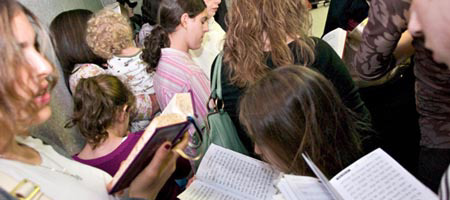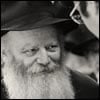In the weeks following the June 12, 1994 passing of the Lubavitcher Rebbe, Rabbi Menachem Mendel Schneerson, of righteous memory, many could be forgiven for forecasting the global network of Chabad-Lubavitch adherents and emissaries as a dying movement.
But in the 13 years since the Rebbe's departure, not only has the Chasidic movement – known both for its uncompromising adherence to Jewish law and its equally unswerving commitment to cater to each and every Jew, regardless of religious observance – grown, but it's demonstrated that the Rebbe is still very much its leader.
"What we see in the constant expansion of Chabad-Lubavitch activities worldwide since the Rebbe's passing," said Rabbi Yehuda Krinsky, one of the Rebbe's longtime aides, at the Lubavitch World Headquarters, "is the unquestioning mesirat nefesh, or self-sacrifice, of the Rebbe's emissaries to spread Judaism in accordance with the Rebbe's teachings. His influence continues to affect Jews and Judaism in so many ways."
Tuesday, June 19, marked the 13th yahrtzeit of the Rebbe's passing on 3 Tammuz, 5754. It was commemorated by dozens of events worldwide, and more than 50,000 people personally visited the Rebbe's resting place at the Old Montefiore Cemetery in Queens, New York, throughout the day.
In addition, the student umbrella organization of the Chabad-Lubavitch movement held a day-long event in Crown Heights, Brooklyn, dedicated to participants' learning those aspects of Jewish scholarship particularly emphasized by the Rebbe, including the writings of Rashi and Maimonides.
Merkos L'inyonei Chinuch, the education arm of Chabad-Lubavitch, sent off hundreds of rabbinical students to locales not served by full time Chabad emissaries for its annual summer program known as Merkos Shlichus.
From Sea to Sea and Beyond
Today, more than 4,000 full-time husband-and-wife teams direct Lubavitch institutions across the globe, from inner-city pre-schools to rural synagogues. An average 1.5 Lubavitch institutions open each week across the globe.
Inside each of these institutions, the Rebbe's emissaries try to emulate the Rebbe's care for each individual.
Since the passing of his father-in-law, Rabbi Yosef Yitzchak Schneersohn, of righteous memory, in 1950, the Rebbe personally met with hundreds of thousands of individuals, some for only a few moments to give them a blessing or a word of advice, along with a dollar to then give to the charity of their choice; others conferred with the Rebbe privately in his modest Brooklyn office. (Private audiences with the Rebbe were possible only until 1980, when the sheer volume of people seeking the Rebbe's counsel rendered it impossible to continue the practice.)
One of those who conferred with the Rebbe in the '70's was Yitzhak Rabin, the late Israeli prime minister, "The first impression that I remember are the eyes of the Rebbe: Blue, penetrating eyes that express wisdom, awareness and deep penetration," the deceased premier related in a 1991 interview with Jewish Educational Media regarding his 1972 meeting with the Rebbe on the occasion of the Rebbe's 70th birthday.
Rabin, then the Israeli ambassador to the United States, delivered personal congratulations from Israeli President Zalman Shazar, a close disciple of the Rebbe's, and the Israeli nation as a whole. Their 45-minute meeting began with a discussion of Rabin's role as the lone voice of Israel in Washington among 120 other nations and progressed to a lengthy examination of the Jewish people's capacity to survive thousands of years of torment, all the while holding fast to its sacred teachings.
The Rebbe "said to me that his main purpose is to spread, to be active, to send all his disciples to work on Jewish education wherever and whenever it is possible," said Rabin in the taped interview, which which was released by JEM in time for the yahrtzeit, along with others, at TheRebbe.org. "He then discussed with me what then was not a matter of public knowledge: his efforts to penetrate beyond the Iron Curtain, to reach the Jewish communities in various parts of the Soviet Union."
After his passing, hundreds of thousands of people, Jews and non-Jews, politicians, shopkeepers and children continue to turn to the Rebbe, flocking to his resting place to say a prayer, recite some Psalms and search for inspiration.
"When he came to America [in 1941]," said Israeli Chief Rabbi Yona Metzger, "he built one of the greatest communities in America, and from America he [strengthened] Judaism all over the world."
Metzger was the keynote speaker at a June 14 Evening of Tribute in New York, at the Rebbe's resting place, which was attended by 1,200 people.
"The emissaries …have the biggest budget [among] all the [Jewish] organizations all over the world," continued Metzger. "But the Rebbe was rich not for economic reasons. He was rich [because of] all the Jewish people who began to understand why they are Jews, who came back to G‑d to pray to Him and to keep the Torah."
Looking back, Krinsky sees a world improved by the Rebbe's campaigns for increased observance of Judaism, noting for example that 15 million Jewish men laid tefillin since the Rebbe's inauguration of the tefillin campaign before the Six Day War in 1967, and so much more. He changed the landscape of Jewish life the world over.
"The Rebbe helped so many; he had a profound love of all Jews, constantly challenging all of us in his public talks and writings to live a better Torah-true life," Krinsky explained. "He changed the landscape of Jewish life the world over — and he continues to challenge us, whether it be in the collections of his talks, the memories of those who met him, or the audio recordings and video footage of his public speeches."









Start a Discussion